Fujian Province, Republic of China
| Fujian Province 福建省 | ||
|---|---|---|
| Streamlined Province of the Republic of China | ||
| Name transcription(s) | ||
| • Chinese | 福建省 (Fújiàn Shěng) | |
| • Abbreviation | FJ / 閩 (pinyin: Mǐn, POJ: Bân) | |
| • Hokkien POJ | Hok-kiàn | |
| • Fuzhou | Hók-gióng | |
| ||
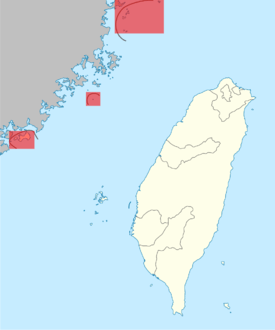 Map showing the location of Fujian Province | ||
| Coordinates: 24°25′N 118°19′E / 24.417°N 118.317°ECoordinates: 24°25′N 118°19′E / 24.417°N 118.317°E | ||
| Succeed from Fukien Province of Qing Empire along with establishment of ROC | January 1, 1912 | |
| Split of Fukien | August 17, 1949 | |
| Streamlined | July 16, 1956 | |
| Demilitarized | November 7, 1992 | |
| Named for | See Fujian | |
| Capital | Jincheng (de facto) | |
| Divisions | 2 (de facto) counties, 7 (de facto) townships, cities | |
| Government | ||
| • Governor | Chang Ching-sen | |
| Area | ||
| • Total | 180.4560 km2 (69.6745 sq mi) | |
| Population (July 2018) | ||
| • Total | 151,028 | |
| • Density | 840/km2 (2,200/sq mi) | |
| Demographics | ||
| • Languages and dialects | Quanzhou dialect (dialect of Southern Min) in Kinmen, Matsu dialect (dialect of Eastern Min) in Matsu, Putian dialect (dialect of Pu-Xian Min) in Wuqiu | |
| Time zone | UTC+8 | |
| Postal codes | 209–212, 890–896 | |
| Area codes | (0)82, (0)826, (0)836 | |
| ISO 3166 code | TW | |
| GDP (N/A) | NTD N/A (N/A) | |
| • per capita | NTD N/A (N/A) | |
| HDI (N/A) | N/A (N/A) (N/A) | |
| Website |
www | |

Fujian, formerly romanized as Fukien or Fuchien (Chinese: 福建省; pinyin: Fújiàn Shěng; Pe̍h-ōe-jī: Hok-kiàn-séng, see other names below), is a streamlined province of the Republic of China. It includes the small archipelagos of Kinmen (Quemoy) and Matsu Islands off the southeast coast of the People's Republic of China. The seat of the provincial government is Jincheng Township of Kinmen County.[1]
The current Fujian Province under ROC control was once part of a larger Fujian Province, which consisted of a mainland portion and some islands. After the Chinese Civil War of 1949, the majority of the historical province became Fujian, People's Republic of China, while the remaining islands remained under ROC control, which compose 0.5% of ROC's territories.
History
Imperial China
The Han dynasty collapsed at the end of the 2nd century AD, paving the way for the Three Kingdoms era. Sun Quan, the founder of the Kingdom of Wu, spent nearly twenty years subduing the Shan Yue people, the branch of the Yue living in mountains.
The first wave of immigration of the noble class arrived in the province in the early 4th century when the Western Jin dynasty collapsed and the north was torn apart by invasions by nomadic peoples from the north, as well as civil war. These immigrants were primarily from eight families in central China: Lin (林), Huang (黄), Chen (陈), Zheng (郑), Zhan (詹), Qiu (邱), He (何), and Hu (胡). The first four remain as the major surnames of modern Fujian.
Nevertheless, isolation from nearby areas owing to rugged terrain contributed to Fujian's relatively backward economy and level of development, despite major population boost from northern China during the "barbarian" invasions. Population density in Fujian remained low compared to the rest of China. Only two commanderies and sixteen counties were established by the Western Jin dynasty. Like other southern provinces such as Guangdong, Guangxi, Guizhou, and Yunnan, Fujian often served as a destination for exiled prisoners and dissidents at that time.
During the Southern and Northern Dynasties era, the Southern Dynasties reigned south of the Yangtze River, including Fujian.
The Tang dynasty (618–907) oversaw the next golden age of China. As the Tang dynasty ended, China was torn apart in the period of the Five Dynasties and Ten Kingdoms. During this time, a second major wave of immigration arrived in the safe haven of Fujian, led by general Wang, who set up an independent Kingdom of Min with its capital in Fuzhou. After the death of the founding king, however, the kingdom suffered from internal strife, and was soon swallowed up by Southern Tang, another southern kingdom.[2]
Quanzhou was blooming into a seaport under the reign of the Min Kingdom, and is the largest seaport in the world. Its population is also greater than Fuzhou.[3][4] Due to the Ispah Rebellion, Quanzhou was severely damaged. In the early Ming dynasty, Quanzhou was the staging area and supply depot of Zheng He's naval expeditions. Further development was severely hampered by the sea trade ban of the Ming dynasty, and the area was superseded by nearby ports of Guangzhou, Hangzhou, Ningbo and Shanghai despite the lifting of the ban in 1550. Large scale piracy by Wokou (Japanese pirates) was eventually wiped out by Chinese military and Japanese authority of Toyotomi Hideyoshi.
Qing Dynasty
Late Ming and early Qing dynasty symbolized an era of large influx of refugees and another 20 years of sea trade ban under the Kangxi Emperor, a measure intended to counter the refuge Ming government of Koxinga in Taiwan. Incoming refugees, however, did not translate into a major labor force owing to their re-migration into prosperous regions of Guangdong. In 1683, the Qing dynasty conquered Taiwan and annexed it into Fujian province, as Taiwan Prefecture. Settlement of Taiwan by Han Chinese followed, and the majority of people in Taiwan are descendants of Hoklo people from Southern Fujian. Fujian arrived at its present extent after Taiwan was split as its own province in 1885.[5] Just ten more years later, Taiwan Province would be lost to Japan due to the Qing losing the First Sino-Japanese War which ended in 1895.
Republic of China (After 1950)
During the Chinese Civil War, the ROC lost control of mainland China, including most of Fujian province, and was forced to relocate to Taiwan, while the victorious Chinese Communist forces established the PRC in 1949, subsequently the capital of Fujian was also moved from Foochow to Jincheng. In the Battle of Guningtou, however, ROC forces were able to defend the island of Quemoy (Kinmen) just off the coast of Fujian from communist attack. As a result, the ROC has been able to hold on to a number of offshore islands of Fujian, and has continued to maintain a separate Fujian Provincial Government to govern these islands, parallel to the province of Fujian in mainland China.
In 1956, due to heightened potential for military conflict with the PRC, the ROC central government moved the Fujian provincial government out of Fujian to within Taiwan Province in Xindian (now part of New Taipei), and the islands were placed under an extraordinarily tight military administration due to their extreme proximity to mainland China. This was an unusual situation where the government of a province was located and operating in a different province. With the easing of cross-strait relations between the PRC and ROC and the democratization of the ROC in the 1990s, the islands were returned to civilian government in 1992. On January 15, 1996, the provincial government moved back to Kinmen, on Fujian soil.[6]
Recently, the ROC has significantly diluted the powers of the two provinces it governs, namely Taiwan and Fujian. Most of the authority at the Fujian province level has been delegated to the two county governments of Kinmen and Lienchiang.
Subdivisions
Fujian province comprises two counties: Kinmen County and Lienchiang County. These islands have a total area of 182.66 km2 (70.53 sq mi) and a total population of 71,000 (2001).
The following are the islands of Fujian under the administration of the ROC, given by county:
| Kinmen County (金門縣) | Lienchiang County (連江縣) |
|---|---|
|
|
The PRC claims Kinmen as Jinmen County, Quanzhou, Fujian; Matsu Islands as Mazu Township, Lianjiang County, Fuzhou, Fujian.
Government

List of Chairpersons
| № | Portrait | Name (Birth–Death) |
Term of Office | Political Party | |
|---|---|---|---|---|---|
| 1 |  |
Yang Shu-chuang[7] 楊樹莊 Yáng Shùzhuāng (1882–1934) |
1 May 1927 | 7 December 1932 | Kuomintang |
| Concurrently held position as Minister of the Navy. | |||||
| — | Chen Nai-yuan 陳乃元 Chén Nǎiyuán |
5 February 1929 | 6 January 1930 | Kuomintang | |
| As acting; head of Provincial Civil Affairs Department. | |||||
| — |  |
Fang Sheng-tao 方聲濤 Fāng Shēngtāo (1885–1934) |
6 January 1930 | 7 December 1932 | Kuomintang |
| As acting; head of Provincial Public Security Department. | |||||
| 2 | Chiang Kuang-nai[7] 蔣光鼐 Jiǎng Guāngnài (1888-1967) |
7 December 1932 | 20 December 1933 | Kuomintang | |
| 3 |  |
Chen Yi 陳儀 Chén Yí (1883-1950) |
12 January 1934 | 28 August 1941 | Kuomintang |
| 4 | 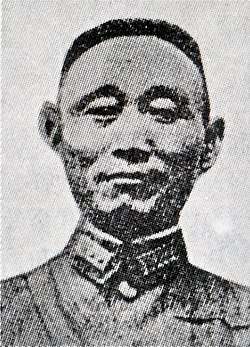 |
Liu Chien-hsü[7] 劉建緒 Liú Jiànxù (1892-1978) |
28 August 1941 | 16 September 1948 | Kuomintang |
| 5 | Li Liang-jung 李良榮 Lǐ Liángróng (1906-1967) |
16 September 1948 | 20 January 1949 | Kuomintang | |
| 6 |  |
Chu Shao-ling[7] 朱紹良 Zhū Shàoliáang (1891-1963) |
20 January 1949 | 4 October 1949 | Kuomintang |
| — | Fang Chih[8] 方治 Fāng Zhì (1895–1989) |
18 August 1949 | 30 September 1949 | Kuomintang | |
| As acting; Member of the National Assembly. | |||||
| — | Huang Chin-tao 黃金濤 Huáng Jīntāo (1888–1957) |
30 September 1949 | 23 November 1949 | Kuomintang | |
| As acting; head of Provincial Public Works Department. | |||||
After Relocation to Kinmen
| № | Portrait | Name (Birth–Death) |
Term of Office | Political Party | |
|---|---|---|---|---|---|
| 7 | 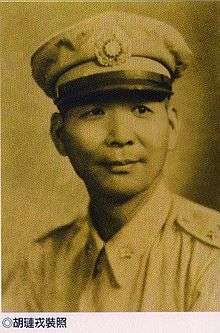 |
Hu Lien 胡璉 Hú Liǎn (1907–1977) |
23 November 1949 | 1 February 1955 | Kuomintang |
| Concurrently held position as Commander of the Kinmen Defense Command. Provincial Government relocated to Xindian, Taipei County, Taiwan on 4 December 1949. | |||||
| 8 | Tai Chung-yu 戴仲玉 Dài Zhòngyù (1910–1986) |
1 February 1955 | 21 May 1986 | Kuomintang | |
| Longest serving chairperson. Died in office. | |||||
| 9 | Wu Chin-tzan 吳金贊 Hú Liǎn (1935–2012) |
20 June 1986 | 9 February 1998 | Kuomintang | |
| Provincial Government returned to Kinmen on 15 January 1996. | |||||
| 10 | Yen Chung-cheng 顏忠誠 Yán Zhōngchéng |
10 February 1998 | 21 May 2007 | Kuomintang | |
| — | Yang Cheng-hsi 楊誠璽 Yáng Chéngxǐ |
21 May 2007 | 28 November 2007 | Kuomintang | |
| As acting; head of the First Division of the Provincial Government. | |||||
| 11 | Chen Chin-jun 陳景峻 Chén Jǐngjùn (1956–) |
28 November 2007 | 20 May 2008 | Democratic Progressive Party | |
| Concurrently held position as Secretary General of the Executive Yuan. | |||||
| 12 | Hsueh Hsiang-chuan 薛香川 Xūe Xiāngchuān (1944–) |
20 May 2008 | 10 September 2009 | Kuomintang | |
| Concurrently held position as Secretary General of the Executive Yuan. | |||||
| 13 | James Hsueh 薛承泰 Xūe Chéngtài (1956–) |
10 September 2009 | 18 February 2013 | Kuomintang | |
| Concurrently held position as Minister Without Portfolio. | |||||
| 14 | Chen Shyh-kwei[9] 陳士魁 Chén Shìkúi (1952–) |
18 February 2013 | 1 August 2013 | Kuomintang | |
| Concurrently held position as Minister Without Portfolio. | |||||
| 15 | 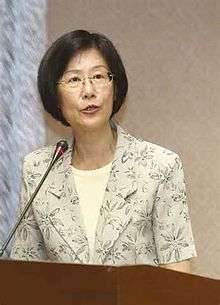 |
Luo Ying-shay 羅瑩雪 Luó Yíngxuě (1951–) |
1 August 2013 | 29 September 2013 | Kuomintang |
| Concurrently held position as Minister Without Portfolio and as Minister of the Mongolian and Tibetan Affairs Commission. | |||||
| 16 | Schive Chi[10] 薛琦 Xuē Qí |
29 September 2013 | 25 March 2014 | ||
| Concurrently held position as Minister Without Portfolio. | |||||
| 17 | 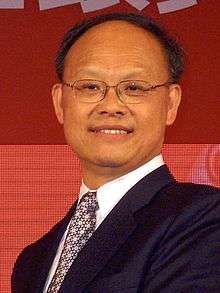 |
John Deng 鄧振中 Dèng Zhènzhōng (1952–) |
25 March 2014 | 7 December 2014 | |
| Concurrently held position as Minister Without Portfolio. | |||||
| 18 |  |
Woody Duh 杜紫軍 Dù Zǐjūn (1959–) |
7 December 2014 | 31 January 2016 | Independent |
| Concurrently held position as Minister Without Portfolio. | |||||
| 19 | 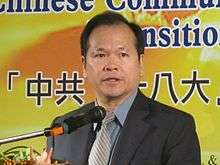 |
Lin Chu-chia 林祖嘉 Lín Zǔjiā (1956–) |
31 January 2016 | 20 May 2016 | |
| Concurrently held position as Minister Without Portfolio and as Minister of the National Development Council. | |||||
| 20 | .jpg) |
Chang Ching-sen 張景森 Zhāng Jǐngsēn (1959–) |
20 May 2016 | Incumbent | Independent |
| Concurrently held position as Minister Without Portfolio. | |||||
See also
References
- ↑ Between 1956 and 1996, Xindian City in Taipei County served as the seat of government.
- ↑ Fukien. (2008). In Encyclopædia Britannica. Retrieved December 20, 2008, from Encyclopædia Britannica Online: http://www.britannica.com/EBchecked/topic/221639/Fujian
- ↑ 伊本・白图泰(著)、马金鹏(译),《伊本・白图泰游记》,宁夏人民出版社,2005年
- ↑ "中国网事:千年古港福建"泉州港"被整合改名引网民争议". 新华网. Retrieved 2014-08-17.
- ↑ Skinner, George William; Baker, Hugh D. R. (1977). The City in late imperial China. Stanford University Press. p. 197. ISBN 978-0-8047-0892-0. Retrieved 19 January 2012.
- ↑ Fujian Provincial Government website Archived April 14, 2009, at the Wayback Machine.
- 1 2 3 4 Cahoon, Ben. "China Provinces and Administrative Divisions". www.worldstatesmen.org. World Statesmen. Retrieved 2 October 2015.
- ↑ Cahoon, Ben. "China Provinces and Administrative Divisions". www.worldstatesmen.org. World Statesmen. Retrieved 2 October 2015.
(In Columns) “(May 1949 - 23 Nov 1949) (Fang Zhi) (Fang Chih) (Nationalist) (at Kinmen from 17 Aug 1949) (b. 1895 - d. 1989)”
- ↑ "Executive Yuan, R.O.C. (Taiwan)-Executive Yuan Officials". Ey.gov.tw. Archived from the original on 2014-05-18. Retrieved 2014-05-18.
- ↑ "Executive Yuan, R.O.C. (Taiwan)-Executive Yuan Officials". Ey.gov.tw. Retrieved 2014-05-18.
External links
| Wikimedia Commons has media related to Fujian Province, Republic of China. |
- ROC Fujian Provincial Government (in Chinese)

.svg.png)
